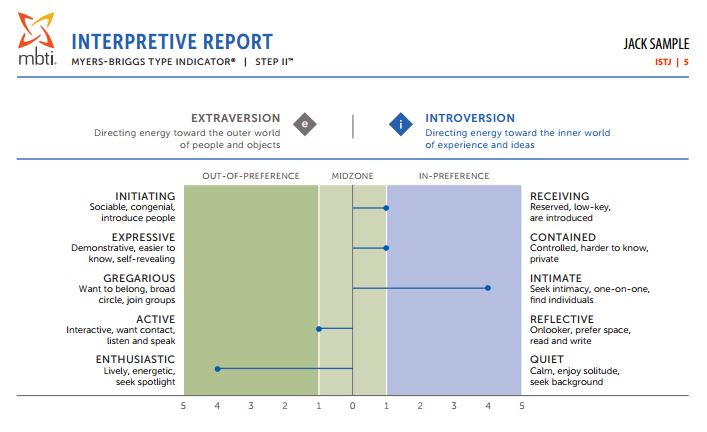
MBTI Step II Assessment Report
MBTI Step II Assessment and Report
Most people are familiar with the Myers Briggs Step I instrument. This is the basic MBTI that tells you which one of the 16 available MBTI Types you might be. Ie ENFP or ESTP etc. It is the basic MBTI that most people are familiar with. Much less known is the MBTI Step II version which is rather unfortunate, because I find it a most valuable tool in developing increased self-awareness.
In fact, there are three common challenges with relying on Step I results:
- Some people do not have all the attributes associated with a Type preference. ie Initiating, Expressive, Gregarious, Active or Enthusiastic
- Some people have unclear preferences on one or more preference pairs and finally…
- Basic Typing fails to demonstrate within-Type differences
The MBTI Step II Assessment and accompanying Interpretive Report results usually reveal these differences
What is the MBTI Step II assessment?
From the CPP web site: ….. “The basic versions of the Indicator (Form M and the earlier Form G) yield type descriptions distinguishing the sixteen types from one another but offer relatively few clues as to how people of the same type may differ….” Excerpted from MBTI Step II Manual: Exploring the Next Level of Type within the Myers-Briggs Type Indicator® Form Q (Emphasis added)
In undertaking the MBTI Step II assessment, the respondent has to answer an additional 47 questions which help identify the MBTI Step II Facets under each set of preference pairs. (E/I, S/N etc). The MBTI Step II Facets that are measured are as follows:
Extraverting – Initiating, Expressive, Gregarious, Active and Enthusiastic
Introverting – Receiving, Contained, Intimate, Reflective and Quiet
Sensing – Concrete, Realistic, Practical, Experiential and Traditional
Intuiting – Abstract, Imaginative, Conceptual, Theoretical and Original
Thinking – Logical, Reasonable, Questioning, Critical and Tough
Feeling – Empathetic, Compassionate, Accommodating, Accepting and Tender
Judging – Systematic, Planful, Early Starting, Scheduled and Methodical
Perceiving – Casual, Open-ended, Prompted, Spontaneous and Emergent
The MBTI Step II Facets above come complete with descriptions and the extra questions you take will show you where you likely sit on each Facet and whether you are “In Preference” or “Out of Preference” on that Facet. See below
In Preference
When a person has a Facet result that is in keeping with their Preference Pairing, we say they are “In Preference” . In the example below, this person has an “In Preference” result on the Gregarious/Intimate Facet. Note the person is an Introvert – ISTJ.
Out of Preference
When a person has a Facet result that is NOT in keeping with their Preference Pairing, we say they are “Out of Preference” on that facet. So in the example below, this person has an “Out of Preference” result on the Enthusiastic/Quiet facet. Again, note the person is an Introvert – ISTJ. An introvert would normally be associated with Quiet.
Midzone
There is one more option available. It is possible to be in the “Midzone” on any Facet. That is they don’t have a strong preference either way on that Facet. In the diagram below, this is exactly how it looks. This person is an Introvert with a Midzone score on the Initiating/Receiving Facet. In fact they sit Midzone on two other facet preference pairings.
So, three results are possible on any MBTI Step II Facet:
- In Preference
- Out of Preference
- Midzone
As you can see the above information offers richness and depth to your MBTI Type that you just cannot get when using the basic MBTI Step I Assessment.
The purpose of the MBTI Step II Report is to:
- Help to clarify an unclear preference
- Provide descriptions of an individual’s unique way of expressing his/her type
- Helps you better understand others (in more depth)
- Focus on potential areas for development
We now use the MBTI Step II Report in our Team Building programs especially for those who have done the normal Step I, MBTI before. It enables us to construct activities based on a person’s Facet results rather than just their normal Step I preference pairing. These activities can then really target differences within a Type and the results are normally very accurate and very insightful in terms of how a person might behave at work.
Contact us today for more information on how the MBTI Step II Instrument can help your team to function more effectively with this new and intimate knowledge.
And read some Client Feedback on how the MBTI Step II can be used in a team building workshop.

